—
Thanks to the wonderful resources provided by The DCU Silver Age Appearance List, Mike Voiles’ Amazing World of Comics, Tenzel Kim’s The Unofficial DCU Guide, Comic Vine, The Grand Comics Database, Jonathan Woodward’s Annotated Crisis, and Read Comic(s) Online, the Batman Chronology Project proudly presents the Silver/Bronze Age Batman chronology, which details the Batman of the pre-original Crisis EARTH-1. This history comprises Batman and Batman-related DC publications ranging primarily from 1960 through 1986.
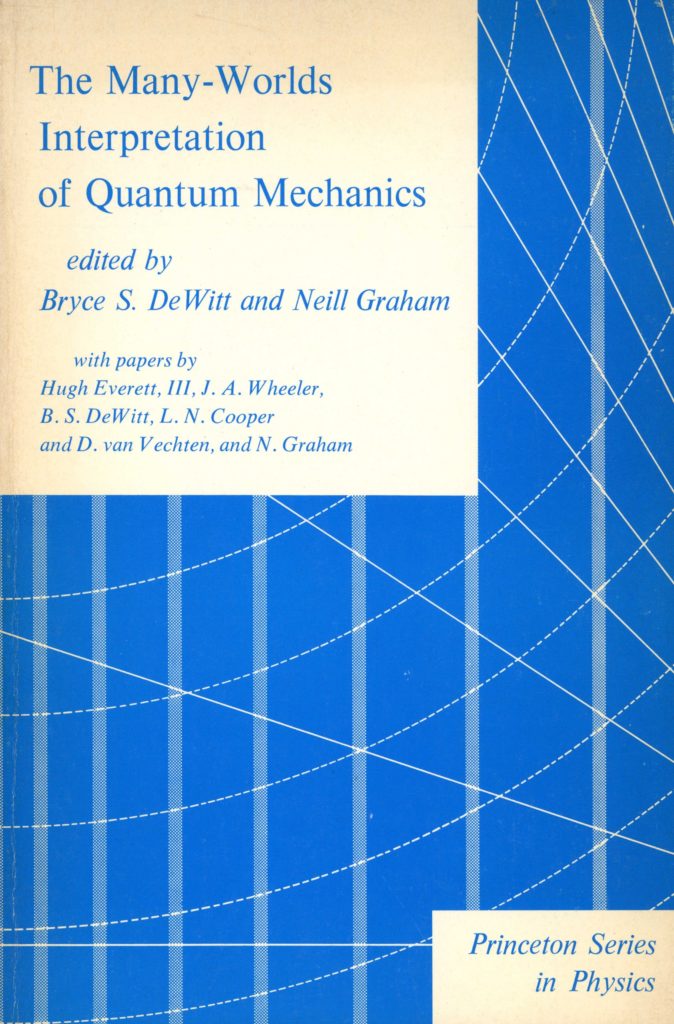
The Many-Worlds Interpretation of Quantum Mechanics
The origins of the Silver Age of comics date back to the 1950s and early 1960s. People often misattribute an augmented narrative use of aliens, monsters, spaceships, computers, robots, and nuclear mutation with the start of the Silver Age. While these tropes surely existed in the early Silver Age, the late Golden Age was rife with this stuff too. The primary thing that more accurately defines the switch from DC’s Golden Age to its Silver Age was a momentous storytelling shift energized by the cutting-edge scientific theories of Bryce DeWitt and new hypotheses about universal wave-function and particle physics by Erwin Schrödinger. The Newtonian model was replaced with the quantum perspective, ushering in a worldview that no longer focused on the physical but instead upon a field of probabilities. In the 1950s and 1960s, the burgeoning “Many-Worlds Interpretation of quantum mechanics” (a replacement for the prior Copenhagen Interpretation) reflected the inchoate fictive concepts that legends like Robert Kanigher and Gardner Fox were putting to pen and paper. While many physicists initially pushed back against such a novel scientific theory, comic book creators were happy to latch on. If a multiverse could be a possibility in the real world, then it certainly had merit within sci-fi superhero comics. Of course, long before Schrödinger’s cat and relative state formulation, the Stoics of the 3rd century BCE (inspired by Heraclitus and Socrates before them) fleshed-out conceptual Multiverse Theory ante litteram. As unheralded comics muse Jorge Luis Borges notes in The Theologians, the Stoics believed in an “infinite cycle of worlds, with infinite suns, moons, Apollos, Dianas, and Poseidons.” In the 50s and 60s, comic book creators deftly layered the Stoic “infinite cycle of worlds” (i.e. a multiverse proper) into their narratives, entering the superhero genre into new levels of heightened visionary literature (in the vein of Margaret Cavendish, Edwin Abbot Abbot, Murray Leinster, or HG Wells). These early superhero narratives, especially ones featuring the multiverse-hopping heroes of the DCU, stimulated the emergence of the literary genre of New Wave science fiction, which was born in the mid 1960s and flourished in the 1970s. Interestingly, despite being directly influenced by comics, New Wave science fiction novels garnered critical praise that the comics themselves had failed to achieve a decade earlier (and wouldn’t achieve for decades to come). Such is the unjust history of “serious literature” thumbing its nose at “funnybooks,” I suppose. Without the multiverse of the Silver Age of comics, maybe we wouldn’t have had Michael Moorcock’s multiverse. (While Moorcock didn’t invent the word “multiverse,” he was first to coin the iteration of the term as we’ve come to know it today.) And without Moorcock, we surely would have been deprived of Alan Moore.
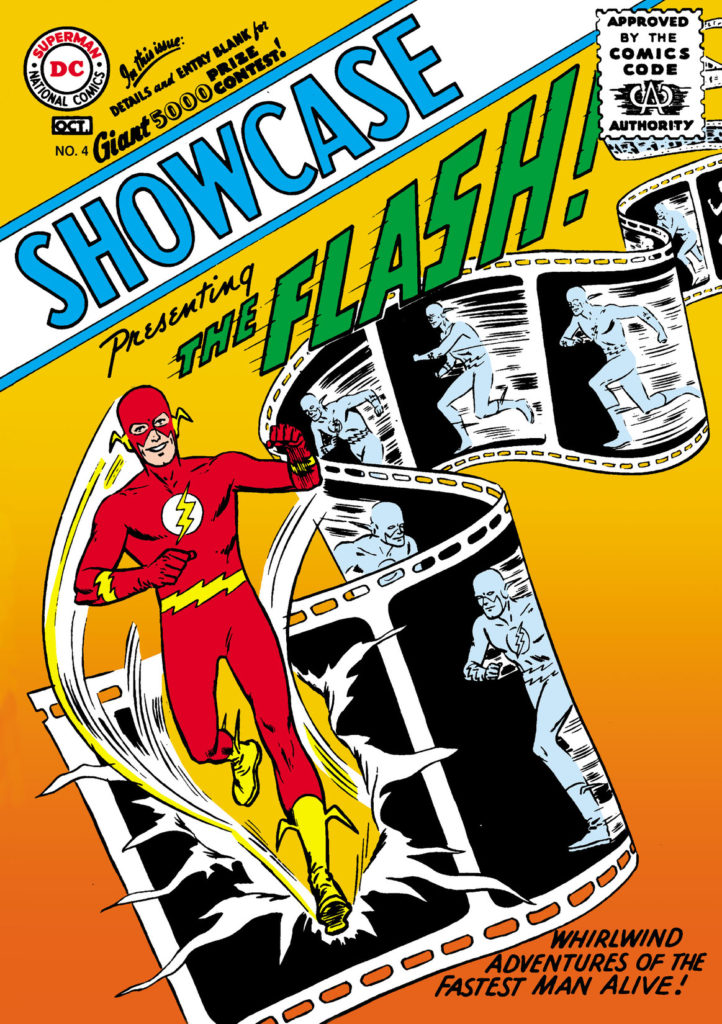
Showcase #4 by Robert Kanigher, Carmine Infantino, & Joe Kubert (1956)
While the inclusion of multiversial storytelling was paradigmatic of Silver Age storytelling, Silver Age writers didn’t immediately create a wider multiverse. Nor did they immediately introduce a brand new Earth. DC’s Silver Age technically began with the rebooting of the Flash in Showcase #4, published October 1956. Showcase #4 ushered in the multiverse, defining two separate Earths, one where Flash is Jay Garrick and the other where Flash is Barry Allen—although the Earths went unnamed. Showcase #4 was a “tryout” to see if rebooting DC’s main characters was worthwhile. It sure was. Thus, Aquaman was also rebooted—either right away in October 1956 with Adventure Comics #229 or as late as 1959’s Adventure Comics #260 (it’s debatable). In 1958, DC also rebooted Wonder Woman (in Wonder Woman #98). In 1959, Green Lantern was rebooted as Hal Jordan (in Showcase #22). Martian Manhunter’s reboot is a special case. He is often regarded as the first Silver Age superhero due to having debuted a year prior to Showcase #4. However, this is a misconception. In my opinion, which is shared by the great historian Craig Shutt, Martian Manhunter was a late-debuting Golden Age superhero. There’s no hint of Martian Manhunter being on an alternate Earth in any of his 1955-1956 appearances. In fact, it wasn’t until much later, in Detective Comics #273 (November 1959), where his character makes a noticeable personality shift. In stark contrast, Flash’s tale from Showcase #4 was an alternate Earth story completely and definitively. (Barry reading Jay Garrick comics undeniably set his world on a different Earth—the prerequisite to understanding this being the fact that the Shazam/Marvel Family home was an alternate Earth seen as fictional comics as well.)
Scholar Rikdad emphasizes the staggered shift from Golden to Silver Age by highlighting key storytelling trends. Rikdad says, “DC stories in [the Golden Age] largely operated on cyclical time, with nothing much ever changing. It was a gradual process from about 1959 to 1969 in which the narrative shifted from cyclical to linear, culminating with marriages (first: [Aquaman then] Barry Allen), deaths (first: Ferro Lad), and growing up (first: Dick Grayson leaving for college). The stories suddenly had beginnings and endings.” Of course, this is not to say that the Golden Age lacked continuity, merely that the type of continuity went from “status quo as story” to “alteration of the status quo as story.”
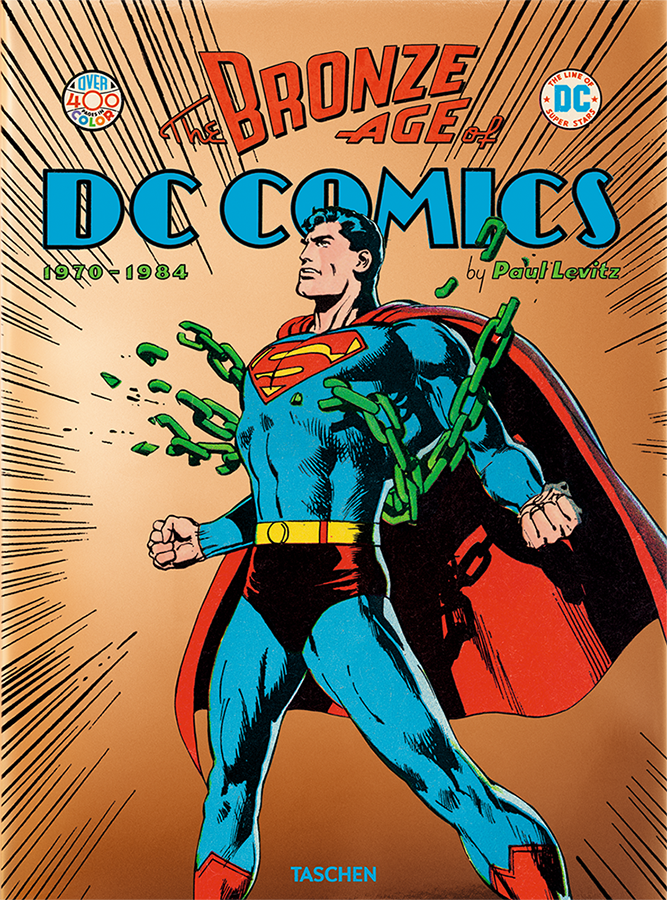
Taschen’s The Bronze Age of DC Comics by Paul Levitz (2015)—with cover art by Neal Adams (1971)
For anyone wondering where the Bronze Age terminology fits into the mix—(after all, the full name of this section of the site is the “Silver/Bronze Age”)—the Bronze Age isn’t really a storyline era; it’s more of a “tone shift” that occurred in the 70s. Basically, the last ten to fifteen years of the Silver Age became known as the Bronze Age–featuring a transition from the PG look and feel of comics in the 60s to the more mature, dark, brooding look and feel of comics in the late 70s and 80s (before the Modern Age begins in 1985). There were no hard reboots associated with the beginnings of the Bronze Age—storylines remained intact and were ongoing at the time. With the abandonment of the Comics Code, superhero stories simply grew darker, edgier, more socially relevant, and more violent, especially with the works of Denny O’Neil and Neal Adams (on Batman and Green Lantern/Green Arrow), Steve Englehart (on Batman), Frank Miller (on Daredevil), Lein Wein and Bernie Wrightson (on Swamp Thing), and (later) Alan Moore (on Swamp Thing). Horror and fantasy merged with the genre in new and exciting ways. At it’s grimmest, Gwen Stacy was brutally murdered before Spider-Man’s very eyes. In the DCU, milquetoast Speedy turned to heroin and even goofball Snapper Carr became an anguished villain. For items specifically published from 1970 through 1986, I will generally use the “Bronze Age” term. However, I will occasionally use “Silver Age” as an overarching term for the entire publication period between the Golden Age and Modern Age.
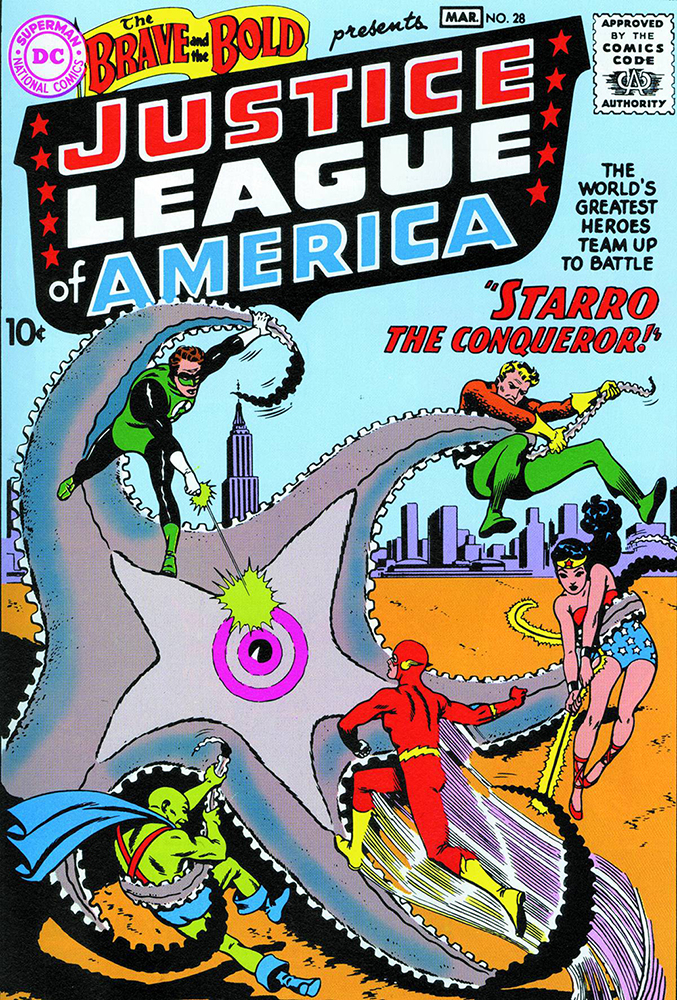
The Brave and The Bold #28 by Gardner Fox, Mike Sekowsky, Bernard Sachs, Joe Giella, & Murphy Anderson (1960)
Back to the staggered character reboots from DC’s Golden Age to Silver Age, here comes the tricky part: DC was hesitant to mess with their two big money makers—Batman and Superman. Thus, most of the secondary characters were being rebooted onto a new Earth, but the Big Two seemingly weren’t. Or were they? Things were so deliberately vague for the Dark Detective and the Man of Steel that there can be varied claims as to when they were rebooted—or even varied interpretations as to which issues go with which Earth. As author Travis Langley says, “The distinction between the original Batman and the [Silver Age Batman] is, to some degree, false. At no point did DC’s creative teams decide, ‘This is our last issue starring the old Batman. Next month we pack and move to Earth-One.’ The earliest appearances retroactively became Earth-Two Batman’s adventures, with no fine distinction as to when the new Batman’s stories began.” In March 1960, The Brave and The Bold #28 debuted a brand new superhero team known as the Justice League of America. This team not only included all the rebooted heroes, but included Batman and Superman too! Up until this point, the public would have been given no indication that Batman and Superman hadn’t been the same Batman and Superman that existed since 1939. (The only possible indicator of an alternate Batman prior to 1960 would have been the multiple references to Robin being much too young, essentially incorrectly keeping him a teen well past the point where he would have been a teen. But as we will see in the Modern Age, the practice of keeping Robins inexplicably youthful will continue well on into the 21st century. The age of Robin is less an indicator of a new Dynamic Duo on a new Earth and more an indicator of poor continuity and a holding-steady of the lame-but-marketable status quo.) The appearance of a Batman and a Superman in the pages of a rebooted JLA book meant that there had to be a separate Batman and Superman on the rebooted Earth as well as an older Batman and Superman that had adventured in the Golden Age on another Earth! Here’s where the different interpretations kicked in. While all JLA stories were obviously occurring on a single Earth, there was literally no way of knowing which non-JLA Batman and Superman stories (i.e. Detective Comics, Batman, Action Comics, Batman, and World’s Finest Comics) were taking place on which Earth. Most non-JLA Batman and Superman stories were insular and never mentioned anything that could function as a clue to placement.
Eventually, the Jay Garrick Golden Age Earth was defined by name as “Earth-2” whereas the Barry Allen/JLA rebooted Silver Age Earth was defined by name as “Earth-1.” This happened in Flash #137 (June 1963). Flash #137, despite fleshing-out the multiverse by naming the Earths and also by showing key differences between them, continued the vagueness in regard to the Big Two. The issue mentions Earth-2 Gotham as home to Green Lantern Alan Scott, but doesn’t even mention Batman at all! And Superman isn’t mentioned either! It’s almost as if there was an editorial mandate simply to not address the Big Two—a message telling readers that they were supposed to remain unsure of which Earth the non-JLA stories were happening on.
However, any confusion could be cast aside a mere month later with the publication of JLA #21-22 (“Crisis on Earth-One and Crisis on Earth-Two”) in August 1963. Since JLA #21-22 hammered in the concept that the JLA’s Batman and Superman were Earth-1 heroes, it basically told readers that the other Batman and Superman belong to Earth-2. But without specifically assigning which Batman went with which Bat-title, things were still a bit murky (in regard to the non-JLA titles).
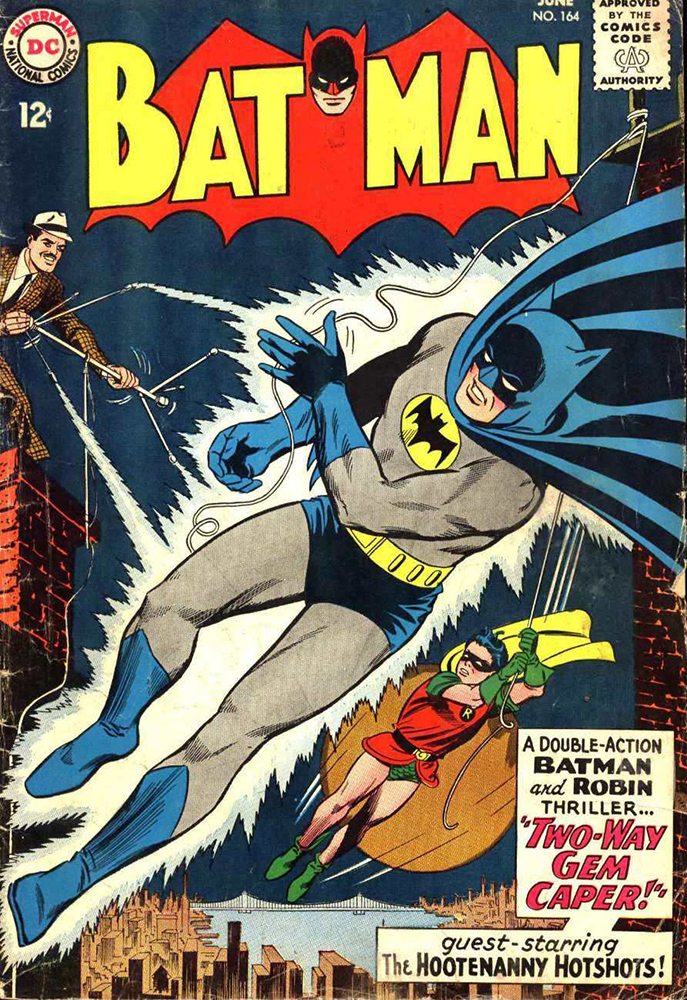
Batman #164 by Ed Herron, Sheldon Moldoff, & Joe Giella (1964)
Around May 1964, hoping to improve falling sales, Julius Schwartz and Carmine Infantino created Batman’s “new look,” switching Batman’s costume from having the classic black Bat-insignia to having a big yellow oval insignia. This change was first shown in Detective Comics #327, Batman #164, and World’s Finest Comics #142. When Batman’s costume immediately reflected this change in the pages of JLA, fans finally knew that the Batman in the main Bat-titles was the same Batman from JLA. Thus, it should come as no surprise that a majority of comics historians mistakenly link Batman’s Silver Age reboot with this iconic costume change. Even DC writer/editor Bob Rozakis, in a 1979 “Ask the Answer Man” column, referred to Batman’s “new look” as the start of Earth-1 storytelling. However, there’s a major flaw in that logic. The JLA Batman, definitively an Earth-1 character, wore the black insignia costume since the JLA’s debut in 1960. While everything after the 1964 yellow oval switch must be Earth-1 Silver Age for sure, any Batman, Detective Comics, or World’s Finest Comics stuff from 1960 up to the 1964 yellow oval switch is still questionable as to which universe it is happening on. Therefore, the yellow oval switch, while important for giving us a definitive Silver Age marker for Batman post May 1964, does little to give us an actual Silver Age starting point.
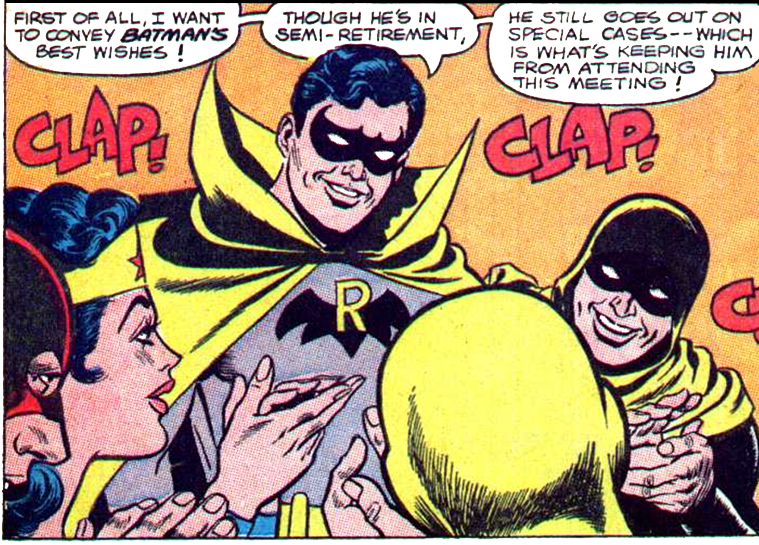
Justice League of America #55 by Gardner Fox, Mike Sekowsky, & Sid Greene (1967)
A great way to determine the start of the Silver Age for Batman and Superman (and to extrapolate further the historical complexity of the Silver Age’s start) would have been to look at when Earth-2 Batman and Earth-2 Superman first show up or get referenced after 1960’s JLA debut. The appearance of said Earth-2 characters would have provided undeniable proof of separate universal existence. Unfortunately, Earth-2 Batman and Earth-2 Superman were conspicuous in their absence not only from “Crisis on Earth-One and Crisis on Earth-Two,” but also from the Silver Age as a whole for a really long time. Earth-2 Superman doesn’t appear in the Silver Age until JLA #73 (August 1969) while Earth-2 Batman doesn’t show up until 1970—although he is referenced in JLA #55 (August 1967). Basically, to reiterate, you have a situation where there are two separate Batmen and Supermen as of March 1960, but this can’t truly be officially confirmed until possibly September 1961 or June-August 1963. And if you were looking for the ultimate proof (i.e. the actual other Batman and other Superman showing up/being referenced in comics), you didn’t get that until August 1967 and August 1969, respectively. Whether or not one could connect the dots and differentiate is unknown, but there really seems to have been a near-decade-long period of doubt as to the universal placement of the Men of Steel (1960-1969) and a four-year-long period of doubt in regard to the universal placement of the Caped Crusaders (1960-1964). The latter controversy ends in 1964 instead of 1967 thanks to the yellow oval switch. Superman’s costume, on the other hand, never changed, making things a bit more difficult for his analysis.[1]
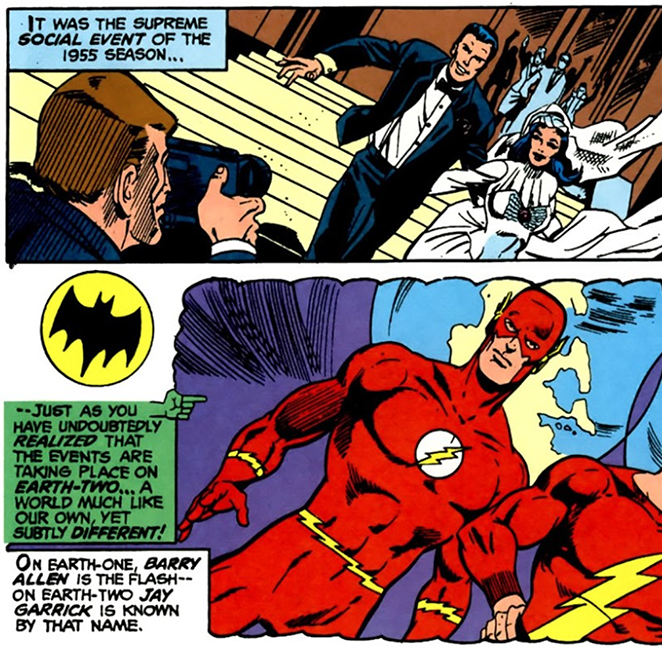
DC Super-Stars #17 by Paul Levitz, Joe Staton, Bob Layton, & Anthony Tollin (1977)
Even throughout most of the 1970s, there was nothing in comics that provided incontrovertible evidence as to the start date for Batman and Superman’s Silver Age (or that provided information allowing one to correctly associate certain issues of Batman, Detective, Superman, Action, or WFC with specific Earths). It’s not until the late 1970s and early 1980s—thanks to several huge retcons—that we are able to start figuring out the exact start of Batman and Superman’s Silver Age lives. These huge retcons dealt specifically with the world of Earth-2 (thus having immediate impact on Earth-1). The biggest of these retcons involve marriage. Clark Kent is said to have retroactively married Lois Lane in the early 50s. Likewise, Bruce Wayne is said to have married Selina Kyle in 1955. This means a lot of things. First, a bunch of late 50s and early 60s stories where Clark and Lois are clearly not married become non-canon on Earth-2. Second, a bunch of late 50s and early 60s stories where Batman is romantically involved with Batwoman become non-canon on Earth-2. Third, a few stories in the 50s where Catwoman returns to crime become non-canon on Earth-2.
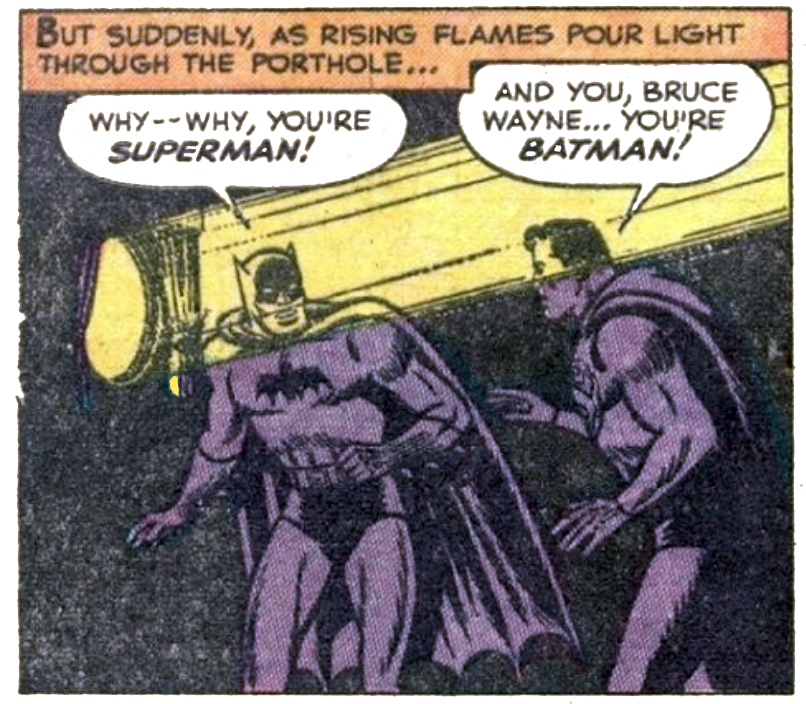
Superman #76 by Edmond Hamilton, Curt Swan, Stan Kaye, & John Fischetti (1952)
The third big 80s retcon is about how and when Superman and Batman first learned each other’s secret identities. Superman #76 (1952) and World’s Finest Comics #71 (1954) depicted the famous SS Varania version of this important event. However, even back in the 50s, the canonicity of Superman #76 was in question since Batman and Superman had learned each other’s IDs years earlier (on the radio show). In the early 80s, DC wanted to define (or redefine) how Batman and Superman learned each other’s secret IDs on each separate Earth. Thus, in 1980 (via Superman Family #201), DC made Superman #76 the canonical version on Earth-2. To further confuse matters, a mere year later (in World’s Finest Comics #271, September 1981), DC changed their minds. Superman #76 was switched and made officially canon on Earth-1 whereas the radio version was made officially canon on Earth-2.
The fourth major 70s/80s retcon is from DC Superstars #17 (1977) and America vs The Justice Society (1985), which introduced the idea that Bruce and Selina’s child, Helena, is born in 1957, at which time, Bruce stops being a socialite, becomes active politically, and “semi-retires” as Batman, no longer going on routine patrols and only working “special cases.”
More late 70s/early 80s retcons to differentiate Earth-2 and Earth-1 occurred as well. Two-Face stays reformed on Earth-2 instead of returning to crime. Thus, any issues that show a reformed Two-Face returning to crime become non-canon on Earth-2. There are many other retcons in the late 50s and early 60s, and while they are mainly about Superman, they also affect Batman as well. These retcons include appearances by Superboy, the Arctic Fortress of Solitude, Lori Lemaris, the Bottle City of Kandor, Supergirl, the Legion, Bizarros, an adult Lana Lang, and other colors of Kryptonite—all of which become non-canon on Earth-2. These Bat-retcons and Super-retcons become the exceptions, which retroactively switch a ton of stories from Earth-2 to Earth-1.
—
So what does the start of my Silver Age Earth-1 timeline look like? First, there are two key dates to keep in mind—July 1954 (i.e. the release of World’s Finest Comics #71, which is definitively heralded—along with Superman #76—as Batman’s first Earth-1 story) and March 1960 (i.e. the debut of the Justice League, an undeniably marker of Batman being on Earth-1). With these key dates in mind, let’s dig in.
Let’s start with Detective Comics first. Detective Comics #277 is the March 1960 release for the title, meaning Detective Comics #277 and all following issues are unequivocally Earth-1 material. However, any issues of Detective Comics prior to this (dating back to July 1954) should be taken on a case-by-case basis in regard to whether or not they violate any retcon exceptions, which would then slide them from Earth-2 to Earth-1. Retcon exceptions include things like Lois and Clark clearly not being married, Bruce and Selina clearly not being married, SS Varania references, or Batman clearly not being “semi-retired” after the birth of his daughter. From July 1954 to March 1960, there are handful of these violators (we’ll list them all below, don’t worry), starting with Detective Comics #218. Notably, Detective Comics #275-276 violate retcon exceptions, making both issues Earth-1 stories. In summary, Detective Comics #218 (April 1955) functions as the actual earliest Detective Comics issue in Earth-1 continuity, with sporadic Detective Comics issues populating Earth-1 from that point until the full switchover in Detective Comics #275 (January 1960).[2]
In regard to World’s Finest Comics, I’m still going with March 1960 as the key date, meaning everything from World’s Finest Comics #108 (March 1960) onward occurs on Earth-1. Of course, just like with Detective Comics, this doesn’t include a large chunk of earlier stories that violate the aforementioned major retcons. With these retcons in mind, we must scrutinize the World’s Finest Comics series more closely (dating back to July 1954), separating the obvious Earth-1 tales from Earth-2 tales. While there are a bunch of World’s Finest Comics issues that violate retcons between July 1954 and March 1960, the first is World’s Finest Comics #71, thus making it the first Earth-1 title of the series. (We’ll list all the violators below.) Notably, World’s Finest Comics #107 violates Bruce’s anti-socialite stance, which he takes in semi-retirement. Therefore, World’s Finest Comics #71 (July 1954) is the first ever World’s Finest Comics issue in Earth-1 continuity, with sporadic World’s Finest Comics issues populating Earth-1 from that point until the full switchover in World’s Finest Comics #107 (February 1960).[3]
Using the March 1960 as our key date for Batman, we have Batman #130 (March 1960) and all following issues functioning as Earth-1 stories. Any parts of issues—(Batman is typically split into three separate stories per issue)—prior to this (dating back to July 1954) must still be highly scrutinized and taken on a case-by-case basis in regard to whether or not they violate any retcon exceptions, which would then slide them from Earth-2 to Earth-1. While there are a bunch of retcon violators between July 1954 and March 1960, Batman #93 Part 3 is the earliest Earth-1 story due to retcon violation. (We’ll list all the violators below.) Notably, Batman #128 and Batman #129 actually violate later retcons about Batwoman’s retirement and about Batman’s semi-retirement policy of no longer routinely patrolling. The second two parts of Batman #127 (parts two and three) also violate later retcons about Bruce’s semi-retirement as well. Therefore, Batman #93 Part 3 (August 1955) is the first ever Batman issue in Earth-1 continuity, with sporadic Batman issues populating Earth-1 from that point until the full switchover in Batman #127 Part 2 (October 1959).[4]
With all that explained, as promised, here is the full list of Earth-1 Batman stories (including May 1952’s Superman #76), spanning July 1954 through early 1960. Aside from World’s Finest Comics #71, these are all Earth-1 stories because they contain some violation of later retcons. By early 1960, all titles become set on Earth-1, at which point Batman is undeniably in the Silver Age.
–Superman #76 (May 1952)
–WFC #71-72 (July 1954-September 1954)
–Detective Comics #218 (April 1955)
–WFC #76-78 (May 1955-September 1955)
–Batman #93 Part 3 (August 1955)
–Batman #94 Part 2 (September 1955)
–Detective Comics #225 (November 1955)
–WFC #80 (January 1956)
–Batman #98 Part 2 (March 1956)
–Batman #99 Part 1 (April 1956)
–Batman #99 Part 2 (April 1956)
–WFC #81 (March 1956)
–Detective Comics #233 (July 1956)
–WFC #84 (October 1956)
–Detective Comics #237 (November 1956)
–WFC #85-86 (December 1956-February 1957)
–Batman #105 Part 1 (February 1957)
–WFC #88-90 (May 1957-October 1957)
–Batman #110 Part 3 (September 1957)
–Batman #111 Part 2 (October 1957)
–Batman #112 Part 3 (December 1957)
–Batman #114 Part 3 (March 1958)
–Detective Comics #249 (November 1957)
–WFC #93 (April 1958)
–Superman #128 Part 2 (April 1959)
–Batman #115 Part 2 (April 1958)
–Detective Comics #250-251 (December 1957-January 1958)
–Detective Comics #255 (May 1958)
–WFC #94 (June 1958)
–Batman #116 Part 2 (June 1958)
–Batman #116 Part 3 (June 1958)
–Detective Comics #256 (June 1958)
–Batman #117 Part 1 (August 1958)
–Batman #117 Part 2 (August 1958)
–WFC #95 (August 1958)
–Action Comics #241 (June 1958)
–Detective Comics #257-258 (July 1958-August 1958)
–Batman #119 Part 1 (October 1958)
–WFC #97 (October 1958)
–Batman #120 Part 2 (December 1958)
–Batman #120 Part 3 (December 1958)
–Batman #121 Part 1 (February 1959)
–Detective Comics #261-262 (November 1958-December 1958)
–Batman #122 Part 3 (March 1959)
–Detective Comics #263 (January 1959)
–WFC #99 (February 1959)
–Batman #123 Part 2 (April 1959)
–WFC #100 (March 1959)
–Superman #132 (October 1959)
–Detective Comics #267 (May 1959)
–WFC #101 (May 1959)
–Batman #124 Part 1 (June 1959)
–Batman #124 Part 3 (June 1959)
–Detective Comics #268 (June 1959)
–WFC #102 (June 1959)
–Batman #125 Part 1 (August 1959)
–Detective Comics #269 (July 1959)
–WFC #103 (August 1959)
–Batman #126 Part 3 (September 1959)
–WFC #104 (September 1959)
–Batman #127 Part 2 (October 1959) (all Batman titles henceforth on Earth-1)
–Batman #127 Part 3 (October 1959)
–Batman #128-129 (December 1959-February 1960)
–Detective Comics #273 (November 1959)
–Detective Comics #275-276 (January 1960-February 1960) (all ‘tec titles henceforth on Earth-1)
–World’s Finest Comics #107 (all WFC titles henceforth on Earth-1)
–final Silver Age transition “officially” begins in March 1960 w/ Batman #130, ‘tec #277, & WFC #108
In conclusion, there really is no set-in-stone undeniable version of when the Silver Age begins for Batman. It will always be open to interpretation. Whether you place the Silver Age start with Showcase #4 in 1956, or split the start dates between different titles going back as far as 1954 (as Voiles does), or start with Strange Adventures #54 in 1955 due to the noticeable editorial shift to sci-fi-heavy storytelling (as Ian at TradeReadingOrder.com does), or if you wait until the yellow oval appears in 1964, or if you start with the JLA debut in 1960—it matters little since none of these are wrong. That being said, I feel very strongly about my version of things. The Batman Chronology Project puts its stamp of approval on the pre-original Crisis Earth-1 timeline that is published on this site. Nothing on the web is more forensic and comprehensive, and I hope that you will agree.
_______________________________
_______________________________________________________________________________________
_______________________________
>>> NEXT: Intro to the Silver/Bronze Age Timeline Part 2 >>>
- [1]COLLIN COLSHER: DC finally answers the question of Superman’s Silver Age start date, or tries to anyway, in 2019’s Doomsday Clock #10. Geoff Johns, via Dr. Manhattan, tells us outright that the Silver Age Superman debuted in 1956, likely taking the Showcase #4 release date and simply applying it to the Man of Steel. Of course, this doesn’t take into account sliding-time—so, while it’s technically correct in regard to true publication history, it’s a gross oversimplification in terms of fictional canon.↩
- [2]COLLIN COLSHER: There is no better scholar on the internet dealing with the transition from Golden Age to Silver Age and specifically how it affects continuity of Earths-1 and 2 other than Mike Voiles. His series of “Fanboy” articles represent the best the dialectic has to offer and have been a tremendous help to me. However, my timeline is different from his. I agree with Voiles when he says to disregard the yellow oval as start of the Earth-1 stories. However, his other rationalizations are unfortunate paralogisms. March 1960 is still the key here. The Brave and The Bold #28 shows us definitively for the first time that there are two Batmen operating on two different Earths. (Showcase #4 and subsequent other character reboots showed us that there were two Earths, but not definitively that there were two Batmen.) Obviously, the retcons made in the late 70s and early 80s must be heeded at all times, but Voiles has every single ‘tec issue starting with issue #203 (1954) as occurring on Earth-1 due to the “fact” that Catwoman returns to crime in #203. First of all, I do not believe that Earth-2 Catwoman never returns to crime after Batman #62. Contrary to very popular belief, Detective Comics #203 (along with its follow-up in Batman #84 and Detective Comics #211) is canon on Earth-2 instead of Earth-1. Voiles argues that Superman Family #211 tells us that Catwoman never returns to crime after going straight. Not so fast. In Superman Family #211, Clark tells Lois a watered-down version of Bruce’s history with Selina, and while the last thing he mentions is her adventure that involves Karl Kyle, that doesn’t necessarily mean that her return to crime didn’t happen. Clark’s interpretation of Catwoman’s career may be legit, but he unequivocally omits parts towards the end. Furthermore, DC Super-Stars #17 (1977) and The Brave and The Bold #197 (1983) tell a joint-story that not only contradicts any flimsy insinuation in Superman Family #211 (1981) that Catwoman never returned to crime, but also shows explicitly that she does return to crime! (In order to turn herself back into the law and serve a legit jail sentence, Selina must have turned back to crime.) Why am I so sure about my version of things? First, two stories that back a certain version of events tend to outweigh one story that backs another. Second, The Brave and The Bold #197, which backs my version, was published the latest (1983), giving it more credence as a finalized retcon tale. Third, the “contradictory” issue (Superman Family #211) isn’t even really contradictory since one can definitely read Clark’s unreliable narration in a way that jibes with the other versions where Selina returns to crime. Fourth, the “Mr. and Mrs. Superman” sections of Superman Family are already littered with continuity errors, including a reference in Superman Family #201 to a definitively non-canon SS Varania adventure that only took place on Earth-1, thus lessening the credibility of what occurs in said sections. Comics historians and narratologists have long tried to simplify chronologies by ignoring things they read, even if they are staring them in the face. It’s all in the text, if you choose to scrutinize. But let’s play Devil’s Advocate. Even if I did agree with Voiles’ history of Earth-2 Catwoman, I wouldn’t mark ‘tec #203 as important of a keystone issue anyway. There’s nothing there that screams “There are two Batmen!” These issues were simply made into Earth-1 stories due to the late 70s/early 80s retcons. And the late 70s/early 80s retcons weren’t meant to change things so that the Silver Age began two years before Showcase #4! If we instead go by March 1960 as the all-important date, then we can determine which issues of Detective Comics, Batman, and World’s Finest Comics start becoming Earth-1 stories (and which function as the final ever Earth-2 stories).↩
- [3]COLLIN COLSHER: Another wee complaint I have about Mike Voiles’ methodology: If an issue from Earth-1 (Silver Age) references or flashes-back to an issue from Earth-2 (Golden Age), Voiles immediately regards that Golden Age issue as no longer canon on Earth-2 and now canon in on Earth-1! That’s not the way things work. Compare that method to what’s going on while curating timelines in the Rebirth/Infinite Frontier Era, New 52, or even in the Modern Age. If something is referenced, it becomes retroactive reference notation material. You don’t add the story in completely! Here’s an example of Voiles’ methodology: he says that, because WFC #251 (a Silver Age Earth-1 tale) references Batman #75 (a Golden Age tale), Batman #75 must only be canon on Earth-1 and no longer canon on Earth-2. Another example: Voiles says that the first appearance of Earth-1 Batman is in Batman #62 because that issue is referenced in WFC #89, which he regards as an Earth-1 book. This doesn’t work for me. Using this type of thinking, Voiles has every issue of WFC from issue #68 up as occurring on Earth-1. Before 1960, you can “copy and paste” specific issues when concinnating continuity timelines, but you cannot simply “cut and paste” large chunks of stories all together. Too many historians, including Voiles, try the latter. DC publishers themselves make a similar mistake. Collected edition trades Batman and Superman: The Silver Age Omnibus #1 (2016) and Batman & Superman in World’s Finest Comics: The Silver Age #1 (2017) both list WFC #71 onward as being Earth-1 tales. WFC #71 may indeed be the first WFC Earth-1 story, but not every single issue thereafter takes place on Earth-1, as we’ll address below.↩
- [4]COLLIN COLSHER: Mike Voiles has Batman #81 and up all listed as Earth-1 stories because issue #81 features Two-Face’s re-scarring and return to crime. However, in my opinion Batman #81 is not canon on Earth-1. The Brave and The Bold #197 clearly states that Two-Face was active in early 1955. Superman Family #211 shows that a rehabilitated and surgically repaired Harvey Kent attends Bruce’s wedding in the summer of 1955. Therefore, on Earth-2, Harvey does indeed become Two-Face again in issue #81. We must merely assume that he reforms shortly after that, as Superman Family tells us. What does it all mean? Not only are most historians totally wrong about this fact, but it also means that we must go by the March 1960 marker once again.↩

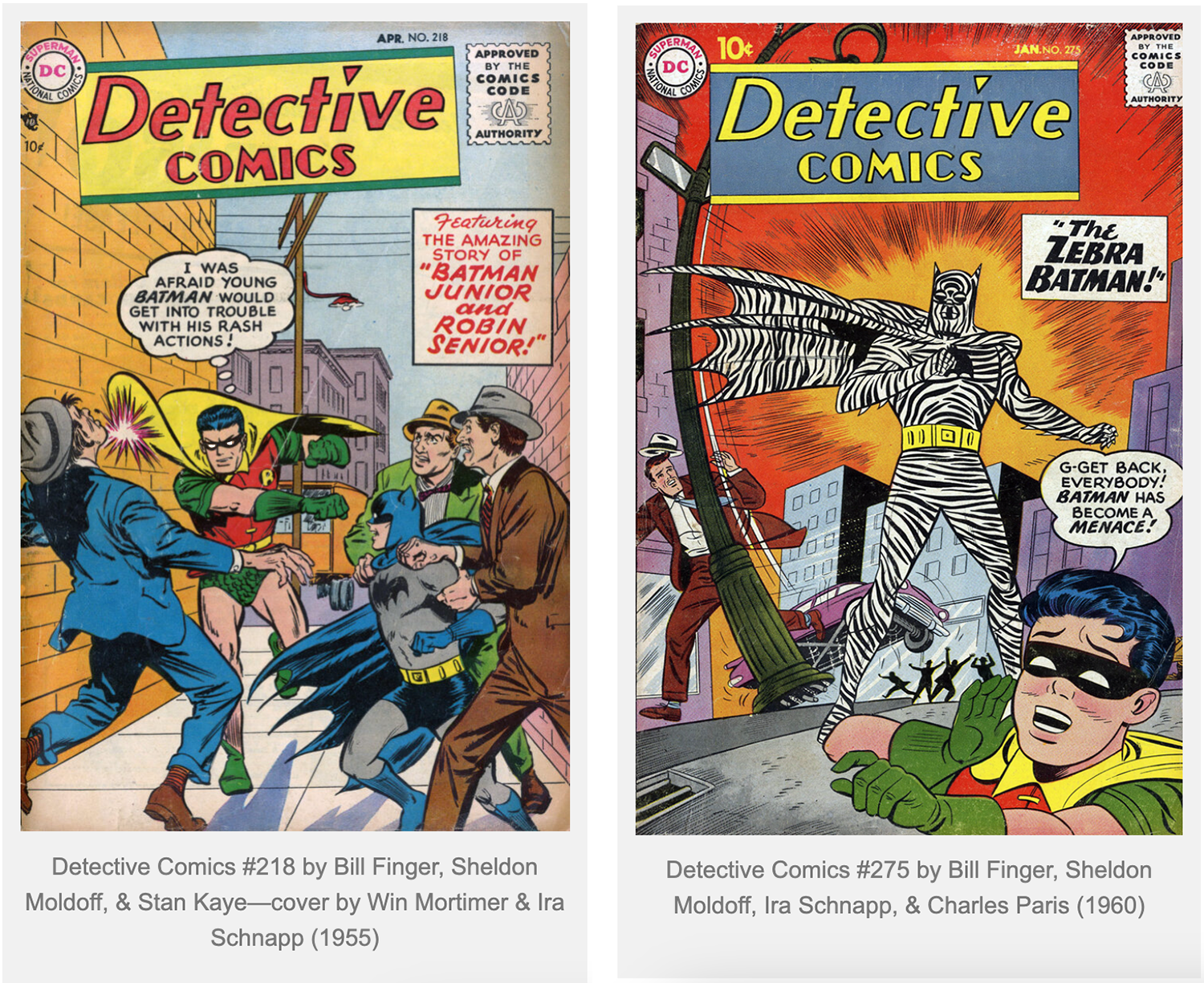
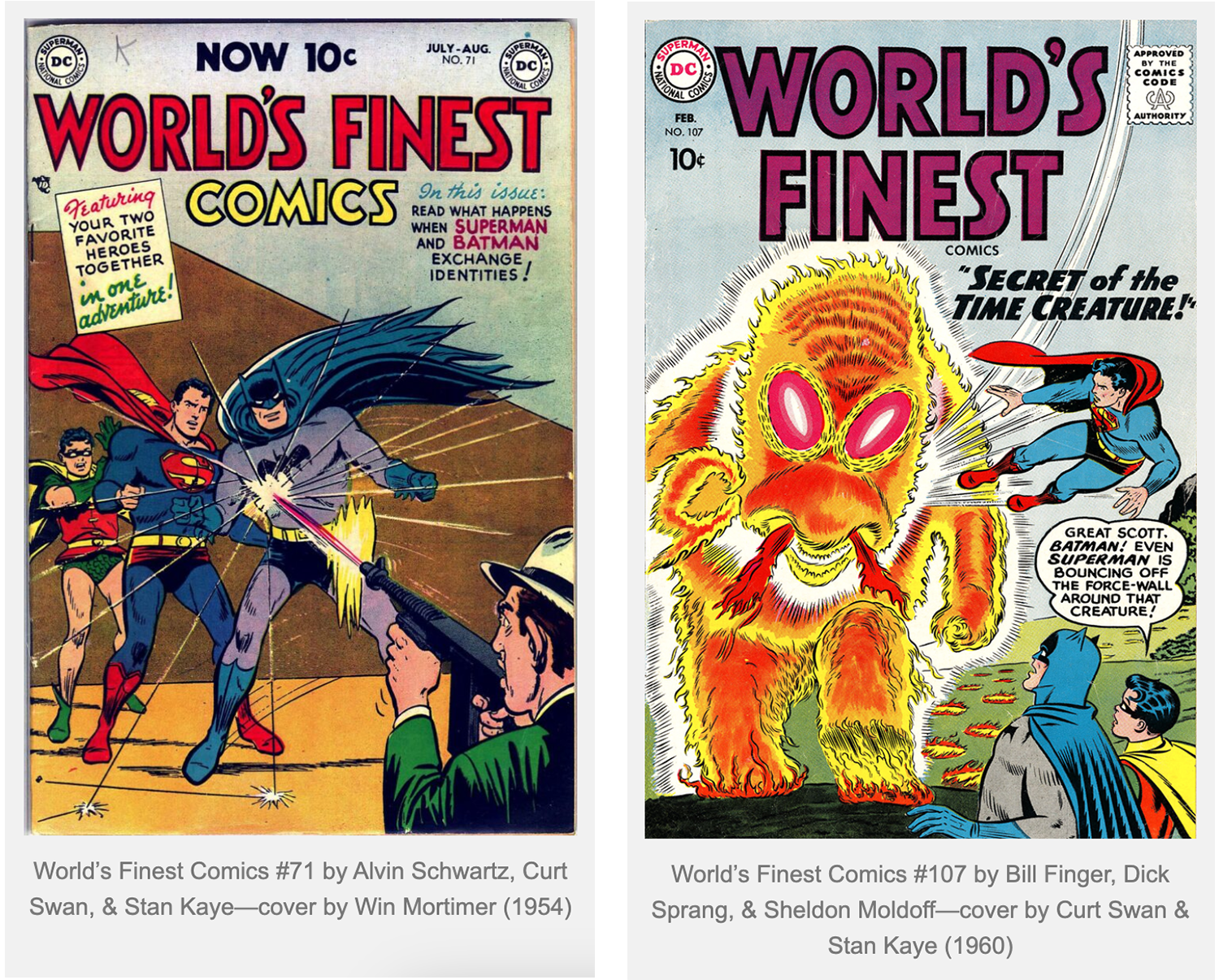


Dear Collin,
I ask your help! I want to start reading Pre-Crisis Batman en masse, but not sure which section/storyline/writer would be a better jumping on-point.
I definitely want to skip the Golden Age and the Silver Age’s early silly parts, so after some research I came up with 2 points that would be good: yellow-oval costume era (Detective Comics #327) or Robin’s departure and relocation from the Batcave (Batman #217)
What do you think? Are these okay-ish points to start with? Or should I go ahead even further to the O’Neill stories?
Thank you in advance!
Honestly, ‘tec #327 signals the primary switch from black insignia to yellow oval. If you are wary of “silly” stuff, then you are still going to get your fill of it ’round ‘tec #327, especially since a lot of this era directly influences the Batman ’66 TV show (and then vice-versa come 1966). However, there’s a lot of great Justice League stuff during this period, so it’s up to you. In terms of JUST Bat-stuff, Batman #217 is probably a better jumping on point for you, based upon what you’ve said above.
And if you haven’t read Batman in the 1970s and early 1980s, you are in for a treat! People love the Steve Englehart run (which I only find so-so), but for my money Denny O’Neil, Len Wein, and Doug Moench are a cut above the rest.
Nice, thank you for the advice! By the way, how is the changelog project going ? 😀
Still on my very long to-do list! Honestly, the continuity in recent months has been such a handful, requiring a lot of extra attention. i.e. it’s been a mess! And with the things up in the air (so-to-speak) in regard to DC’s continuity future, I haven’t had a spare moment to check things off on my queue that aren’t at the very very top. However, aside from the routine timeline building, the ChangeLog is next in line, right alongside adding images to every page. 😉
That’s some good news, once again thanks for the heads-up!
Last question here as I don’t want to flood/spam my messages here too often: when you finished the Silver Age with Batman 400, you mentioned you’re going to revisit the different Crisis stories: have you completed that task and if so, was there any change in the overall chronology project around those times that I should revisit/check?
The write-ups for the OG Crisis was completely overhauled in the Modern Age. As were the write-ups for Zero Hour, Infinite Crisis, AND Final Crisis. So, definitely check ’em out!